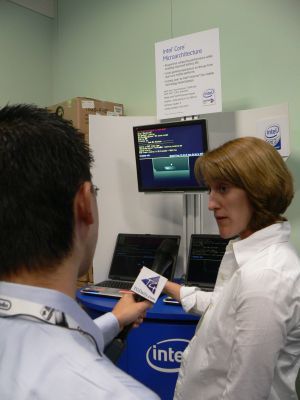Intel: 40% performance claim applies to Core 2 Duo, not yet to Extreme
UPDATE 2:45 pm ET 19 May 2006: Late Thursday, Intel contacted us to update and to correct some of the information regarding last week's performance test at E3. Those corrections appear throughout this article, with a few words of explanation.
Santa Clara (CA) - As the first real-world tests of Intel's new Core 2 Duo and Core 2 Extreme processors continue to be carried out, Intel spokesperson George Alfs told TG Daily late Monday that performance gain figures of 40% greater speed and 40% less power cannot be said to apply specifically to Core 2 Extreme processors just yet - at least, not until tests on the Extreme are completed.
As Alfs told us, Intel's current speed advantage claim is based on a SPECrate test conducted on a Conroe (Core 2 Duo) processor clocked at 2.66 GHz, versus a Pentium D 950 (3.4 GHz). Specific numbers have yet to be released, but Alfs reiterated the Core 2 Duo showed 40% better performance, while using 40% less power. Although SPECrate tests do not measure power consumption, that datum can be obtained simultaneously through independent means.

Intel's Jodi Geniesse demonstrates a Quake 4 rendering test, pairing Core 2 Duo with Pentium M 950, at E3 last week.
At E3 last week, a test with similar results was demonstrated to us by Intel's communications manager for the desktop products division, Jodi Geniesse. The company had taken two identical Toshiba Satellite P105-S921 notebook computers (the model number in the photo is inaccurate). Both models had identical built-in Nvidia GeForce Go 7900 GS GPUs, plus Intel's 945PM Express mobile chipsets.
However, the CPU in the machine on the left, according to Intel, was a Core Duo CPU. Information from Toshiba had indicated to us that the native CPU was actually a Pentium M T2400 (1.83 GHz), though we since learned that some vendors replace this single-core CPU with a higher-performance, dual-core Core Duo. In information we received today, Intel told us the specific Core Duo on the machine on the left was clocked at 2.16 GHz.
Meanwhile, Intel replaced only the CPU for the machine on the right with a Core 2 Duo, although Intel told us today it could not confirm the clock speed of that particular processor.
Stay On the Cutting Edge: Get the Tom's Hardware Newsletter
Join the experts who read Tom's Hardware for the inside track on enthusiast PC tech news — and have for over 25 years. We'll send breaking news and in-depth reviews of CPUs, GPUs, AI, maker hardware and more straight to your inbox.
As the test indicated, the Toshiba with the Core Duo rendered the full battery of 2,725 frames at a rate of 137.2 frames per second. The enhanced Toshiba with the Core 2 Duo rendered the same battery at 182.5 fps - a 33% performance increase. In a further clarification today, Intel said the power consumption envelope between the Sonoma platform machine on the left and the Napa platform machine on the right should be identical.
And let us just say, for the record...Whew!
Power consumption for the new class of mobile gamer, as Intel desktop division general manager David Tuhy told us last week, is critical. Being able to simply make the CPU smaller - from 2 inches down to 1.2" - helps significantly, coupled with staying within a 28 to 35 watt consumption envelope. But in the desktop space, the power consumption equation starts to get significantly fuzzy. "By the time you put in one, two, three of these 150-watt graphics cards," Tuhy said, "you're literally talking about issues of power out of the wall. Some of these systems have two AC power cords coming out the back of them, to be able to draw from their dual power supplies. So it's an impractical case; but in the Extreme space, which is what we're talking about, power is an issue there, too. Certainly it affects the noise; these things all have six fans, three in the front and three in the back, at least."

Intel's general manager for the Desktop Division, David Tuhy.
Tuhy went on to point out that multiple-GPU systems such as Nvidia Quad-SLIs draw a tremendous amount of power. With that comes heat, and with that comes fan rotation, which translates to noise. "So it's an acoustic thing, how much can you do in the box?" Tuhy asked rhetorically. "Preserving heat in the box is going to be a big deal. Some people are going to liquid cooling; we did a cool little advancement to the cooling solution this year, but I think that's going to remain pretty 'niche-y.' That's not going to become very mainstream."
For Viiv form factors using Core 2 Duo, Tuhy continued, power consumption is another critical factor because media center PCs should, by design, consume much less space. "If you put a PC in your living room," he remarked, "you want it to look aesthetically pleasing. That usually means thinner, and usually thinner means lower power. Every time you make it thinner, you want to maintain the same airflow, and the velocity of the fan goes way up.
Although power consumption numbers and performance tests are expected from Intel at some point, we have yet to be told when. In the meantime, one of our readers in TG Forumz has started a thread where independently obtained data is being collected, on both Core 2 Duo and Core 2 Extreme processors.
Most Popular






